Science
Understanding Waves: The Energy All Around Us

Explore the science of waves, from the sound we hear to the light we see, and discover why these energy carriers are crucial to our daily lives.
What is it?
A wave is a disturbance that travels through a medium or space, transferring energy from one point to another without transporting matter. Think of ripples on a pond; the water itself only moves up and down locally, but the energy travels outwards. Waves are broadly categorized into two main types. Mechanical waves, like sound and seismic waves, require a medium (such as air, water, or earth) to travel. In contrast, electromagnetic waves, including light, radio waves, and X-rays, are disturbances in electric and magnetic fields and can travel through the vacuum of space.
Why is it trending?
The study of waves is constantly evolving, with gravitational waves being a major area of recent excitement. First predicted by Einstein, these ripples in spacetime itself are now being detected, opening up a new way to observe the universe. In 2023, scientists announced compelling evidence for a background hum of low-frequency gravitational waves, likely caused by the merging of supermassive black holes. Furthermore, new discoveries include massive, previously unknown waves of stars rippling through our own Milky Way galaxy, challenging our understanding of galactic dynamics.
How does it affect people?
Waves are fundamental to nearly every aspect of modern life and technology. We use electromagnetic waves for all wireless communication, from cell phones and Wi-Fi (radio waves) to television broadcasts. In medicine, waves are essential for diagnostics; X-rays reveal bone structures, while ultrasound provides safe imaging for prenatal care. Sound waves not only enable us to hear and communicate but are also used in sonar technology to navigate and map the ocean floor. From the light that allows us to see to the microwaves that cook our food, our world runs on waves.